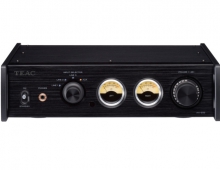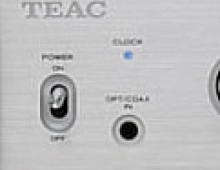TEAC CD-W548E CD-RW
1. Data Reading Tests
TEAC CD-W548E IDE CD-RW - Page 1
- Introduction
![]() At
last, Teac decided to support the 48X recording speed with the CD-W548E. The
previous CD-W540E series deserved our "Editors Choice Award" given
for the widely media compatibility, the high recording speeds and the low seek
times. In the CD-W548E series, TEAC moved from SANYO to MediaTek chipsets and
we will try to examine the possible effects and changes in the drive's performance.
As usual we compare the drive with competitor drives from ASUS, Plextor, CyberDrive
and SONY.
At
last, Teac decided to support the 48X recording speed with the CD-W548E. The
previous CD-W540E series deserved our "Editors Choice Award" given
for the widely media compatibility, the high recording speeds and the low seek
times. In the CD-W548E series, TEAC moved from SANYO to MediaTek chipsets and
we will try to examine the possible effects and changes in the drive's performance.
As usual we compare the drive with competitor drives from ASUS, Plextor, CyberDrive
and SONY.
- Features
As we mentioned in the previous CD-W540E series review, the CD-W548E also supports the Fine Focus Control technology:
 "…The
required strength of the laser varies greatly with writing and reading processes.
With the movement of the write head with conventional CD-R (W) drives, faults
often occur when writing and reading. TEAC has made a breakthrough with the
new "Fine Focus Control" technology, in that the laser always remains
constant and never enters a "jitter mode". The laser remains precisely
in the same position on the track, regardless of the speed. This key CD writing
technology from TEAC enables the high recording quality with very high speeds…"
"…The
required strength of the laser varies greatly with writing and reading processes.
With the movement of the write head with conventional CD-R (W) drives, faults
often occur when writing and reading. TEAC has made a breakthrough with the
new "Fine Focus Control" technology, in that the laser always remains
constant and never enters a "jitter mode". The laser remains precisely
in the same position on the track, regardless of the speed. This key CD writing
technology from TEAC enables the high recording quality with very high speeds…"
The top left picture shows the solution from most manufacturers. Below is what TEAC proposes:

The "Intelligent Speed Control" technology sufficiently tests the status of the CD before the writing process and uses various parameters in order to determine the highest writing speed with the best possible quality. For example, the number of tracks, the disk balance, the power strength of the laser, the type of disk and any possible vibrations with higher rotation speeds are all tested.

- Specifications
The original press release from TEAC claimed that the drive supports the Zone-CLV recording method "...In order to achieve the high writing speed, the new TEAC drive works with Zone Constant Linear Velocity as recording technology. With Zone-CLV the CD is divided into three zones, internally and externally, in which the write speed varies. In more simple terms, the drive is able to automatically synchronize these three zones when burning and consequently can always achieve a linear speed..." However the drive that arrived in our labs supports CLV and P-CAV for the various recording speeds!
The drive's features according to Nero Info Tool are the following:

The drive supports 48X maximum reading / writing and 16X re-writing speeds. The buffer is 2MB and the reading of CD-Text and CD+G is supported. Nero Info Tool also reports that retrieving of C2 error information is supported but its accuracy would be examined later. Mt. Rainier format is also supported. The following pictures show the drive's supported reading/writing speeds:
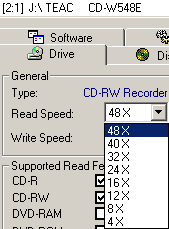

- Recording/Re-writing speeds
The drive supports the 48X recording speed with the use of P-CAV recording technology. As Nero CD Speed revealed, the drive starts writing at 22.82X and gradually reaches the 47.69X speed at 66mins and keeps this speed until the end of the disc. That gives an average of 38.56X, making it probably the fastest 48X recorder. The actual recording results confirmed these CD Speed results.
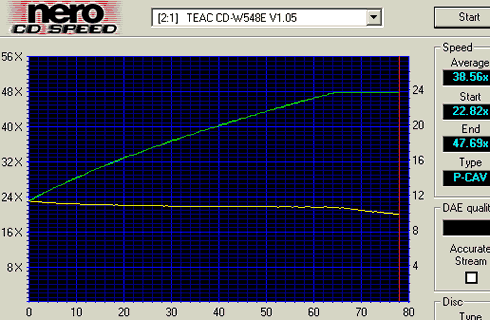
With other CD-R media, the drive's average writing speed can be lower down to 38.22X:
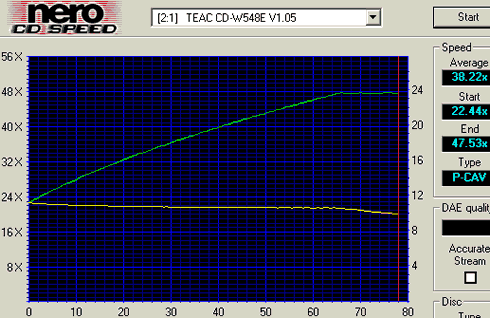
- The package
 The
supplied package is the retail European version and contains: the drive, one
TEAC 80min 52X certified blank disc, a printed operation manual in 7 languages,
mounting screws and audio/IDE cables. The main software is Nero 5.5.x, and InCD
v3.2.x. The drive has a 2-year warranty (only for Europe) and can be found at
the retail price of less than Euro 99.
The
supplied package is the retail European version and contains: the drive, one
TEAC 80min 52X certified blank disc, a printed operation manual in 7 languages,
mounting screws and audio/IDE cables. The main software is Nero 5.5.x, and InCD
v3.2.x. The drive has a 2-year warranty (only for Europe) and can be found at
the retail price of less than Euro 99.
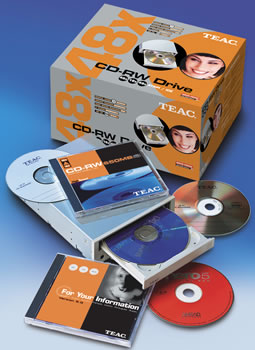
The TEAC 12X-52X CD-R media is based on Mitsui chemicals
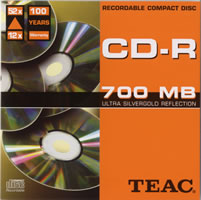

The front panel of the drive is not different than all previous TEAC CD-RW drives. You can see the usual eject button, the headphone input jack/volume selector and two operation led:

The indicator Leds light in Seek, Play, Read, and Write operation. In the following table you will find a brief description of the different drive states and their associated indicator states
|
Operation
|
left LED
|
right LED
|
|
At tray loading/eject
|
OFF
|
Green LED flashes (0.24sec interval)
|
|
During write
|
Green LED flashes (1.48sec interval)
|
OFF
|
|
During Audio Play
|
OFF
|
Green LED flashes (1.48sec interval)
|
|
During Seek/Data transfer
|
OFF
|
Green LED lights
|
|
At start
|
OFF
|
Green LED flashes (0.48sec interval)
|
|
Self-diagnosis error / Start error
|
OFF
|
Green LED flashes (0.24sec interval)
|
On the rear panel of the drive you will find the usual connectors (IDE interface, power), the jumpers for setting the drive to Master/Slave option, three un-used jumpers on the right and the analogue and the digital audio output connectors.


- Inside the drive
After removing the bottom screws we can see the internal of the drive. The drive is based upon MediaTek chipsets, a big change from all previous TEAC recorders that mostly used SANYO chipsets:




- Installation
The TEAC CD-W548E was installed as a Master in the primary IDE BUS. The drive worked in UDMA-33 mode. After booting, it identified itself as a"TEAC CD-W548E". We used Nero v5.5.9.17, CloneCD v4.1.0.1 and Ahead InCD v3.51.61 for the recording tests. The drive is an October 2002 model with firmware revision v1.05 installed.

The drive will automatically reduce the maximum writing speed (48X) when it detects that the inserted media cannot be burned in the selected writing speed. Teac does not offer any way through software/hardware to overpass this feature. The pictures below come from Nero when a non-supported blank media was inserted (maximum speed dropped at 40X).





